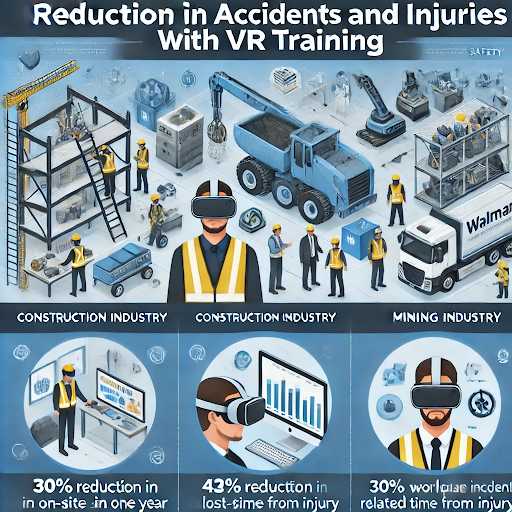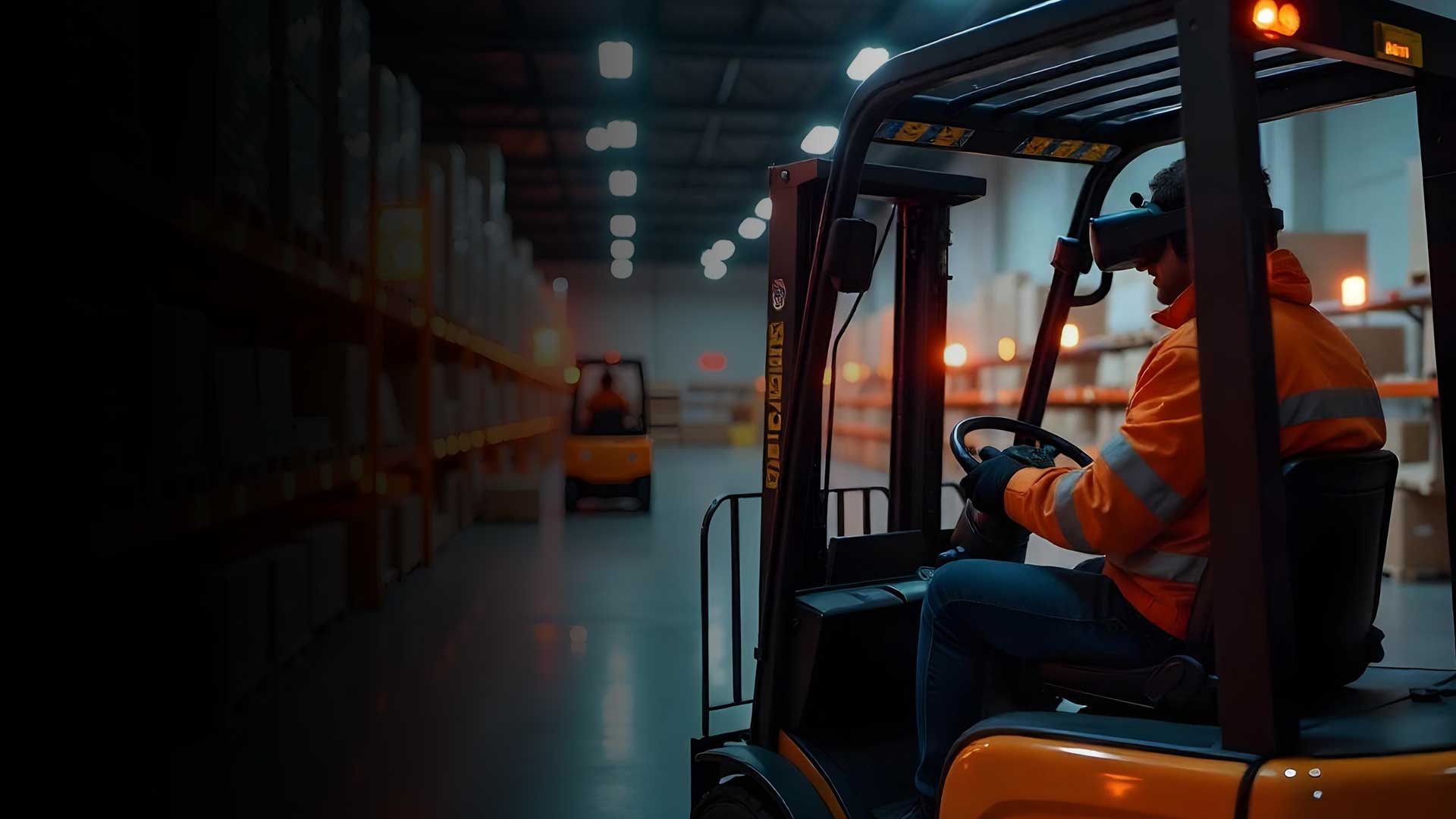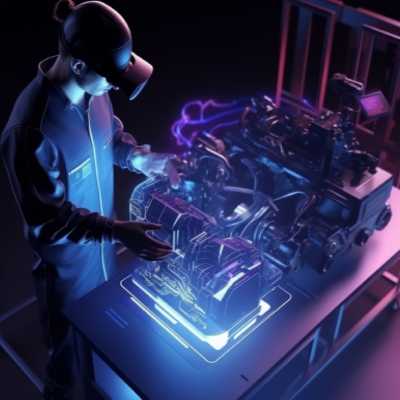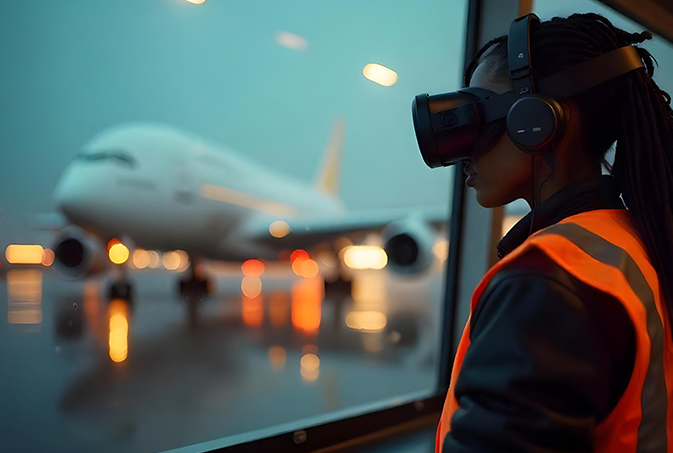Every day, industries around the world face major safety challenges. Manufacturing facilities feature dangerous devices that can be unexpected and pose serious safety risks. When confronted with real-life hazards, traditional safety training frequently fails. Enter Virtual Reality (VR) safety training—a groundbreaking answer to all the safety issues. As a leading VR training development company, we help firms provide immersive, risk-free training that enhances safety protocols and minimizes workplace accidents. This innovative approach prepares workers for real-world scenarios without real danger.
Summary
- VR employee training provider solutions equip workers with the skills needed to handle real-world dangers effectively. Virtual reality safety training enhances retention by 75% compared to traditional methods and is widely used across industries like manufacturing and healthcare.
- VR training excels across industries, like manufacturing and healthcare. It tackles crucial safety topics. Examples include working at heights and handling hazardous materials.
- Companies using VR see significant safety improvements. Equipment incidents drop by 43%. Safety procedure compliance rises by 78%. Emergency response skills sharpen.
- VR training requires an initial investment. Yet, it saves money through fewer incidents and less equipment damage. Operational disruptions also decrease. The financial return often occurs within a year.
- VR systems simulate realistic work environments and risks. They offer targeted training for all staff. No prior tech knowledge is needed.
- VR training enhances decision-making in emergencies. Immersive simulations create high-pressure situations. This leads to better results and safer workplaces.
Transforming Workplace Safety with Modern Training
The workplace safety situation has undergone significant change in recent years. Modern industrial environments are becoming increasingly complicated and challenging, far exceeding the capabilities of traditional training approaches including classroom lectures, video presentations, and printed materials. These traditional approaches often lack the engagement necessary for adequate emergency response preparation.
Global workplace safety data shows worrying statistics: the International Labour Organization reports 2.3 million annual fatalities from industrial events and diseases, with many more non-fatal injuries. This research demonstrates a fundamental gap between theoretical safety knowledge and practical implementation, which custom VR safety training solutions efficiently bridge. By offering immersive, hands-on simulations, VR technology enhances retention, reinforces safety protocols, and ensures workers are better prepared for real-world hazards.
Virtual Reality: Revolutionizing Safety Education
The Power of Immersive Learning
VR employee training providers go beyond standard methods by offering comprehensive immersion in safety training. These systems place participants in fully simulated workplace scenarios, featuring industry-specific risks, equipment, and emergency situations. This multisensory approach significantly enhances learning experiences.
According to research published in the Journal of Educational Psychology, immersive learning improves information retention in the mind of a person by 75% compared to traditional training methods. This significant improvement is due to VR’s ability to activate experiential and visual learning pathways, resulting in strong neural connections for long-term retention.
From Passive Observers to Active Participants
Traditional safety training often positions workers as passive recipients of information. In contrast, a VR training development company transforms learners into active participants who must make real-time decisions with immediate consequences—albeit virtual ones.
Consider a chemical spill scenario: Instead of watching a video about proper response protocols, VR places workers directly in the emergency. They must identify the hazard, select appropriate PPE, communicate with team members, and execute containment procedures—all while a virtual clock ticks down and simulated consequences unfold based on their actions.
Key Applications and Practical Solutions Across Industries
Case Study: Johnson Manufacturing
Johnson Manufacturing implemented custom VR training for heavy machinery operations, focusing on scenarios that had previously resulted in injuries. The results were remarkable:
- 43% reduction in machinery-related incidents within six months
- 67% improvement in hazard identification scores
- 89% of workers reported greater confidence in emergency responses
The VR program simulated specific high-risk procedures, allowing operators to practice responses to equipment malfunctions, emergency shutdowns, and unexpected situations in a risk-free environment. Trainees could make mistakes and learn from them without any physical consequences.
Construction Safety: Working at Heights
Construction ranks among the most dangerous industries, with falls accounting for a significant percentage of fatal accidents. Virtual Reality training for businesses offers particular advantages for height-related work:
- Workers can experience realistic height conditions in VR, triggering genuine psychological responses
- Training can replicate specific job site conditions, from scaffolding to crane operations
- Scenarios can introduce unexpected complications like weather changes or equipment failures
One major construction firm reported that after implementing VR fall protection training, safety compliance increased by 78%, and workers demonstrated significantly improved hazard awareness during actual high-elevation tasks.

Healthcare: Emergency Response Training
Pandemic Preparedness
The COVID-19 pandemic highlighted the critical importance of emergency preparedness in healthcare settings. Several hospital systems adopted VR training to prepare staff for:
- Proper donning and doffing of PPE
- Triage scenarios during patient surges
- Ventilator management in crises
These programs allowed healthcare workers to gain experience in high-pressure scenarios without risk to patients, while also conserving valuable PPE during shortages. Hospitals implementing such training reported higher protocol compliance and reduced infection rates among staff.
Oil and Gas: High-Risk Environment Simulation
Virtual Reality training for businesses in the oil and gas industry enhances safety preparedness through high-risk environment simulations. Offshore platforms and refineries pose extreme challenges, with high-pressure equipment, flammable materials, and remote locations requiring specialized training.
Custom VR safety training solutions for these environments typically include:
- Fire response scenarios with realistic flame behavior physics
- Confined space entry and rescue operations
- Chemical leak containment procedures
Shell reported that after implementing VR safety training across multiple sites, emergency response times improved by 53%, and workers demonstrated significantly higher proficiency in equipment shutdown procedures during simulated emergencies.
Industry-Specific Applications and Impact Analysis
Construction Safety Enhancement
- Challenge: High-risk construction environments present hazards including elevated work, heavy machinery operation, and hazardous material exposure.
- Implementation: VR simulations provide realistic training scenarios for scaffolding work, rooftop operations, and equipment handling protocols.
- Impact: Organizations report 43% reduction in fall-related incidents following VR training implementation.
Healthcare Emergency Response
- Challenge: Medical professionals require precise decision-making capabilities during critical situations.
- Implementation: VR platforms simulate emergency scenarios including cardiac response, enabling practice of CPR techniques, defibrillator operation, and emergency protocols.
- Impact: Enhanced emergency response efficiency, improved team coordination, and increased patient survival rates.
LOTO Protocol Training
- Challenge: Equipment maintenance requires strict adherence to shutdown procedures preventing unexpected activation.
- Implementation: Interactive VR modules guide maintenance personnel through comprehensive LOTO procedures and equipment security protocols.
- Impact: Significant reduction in equipment-related incidents and enhanced workplace safety compliance.
Hazardous Material Management
- Challenge: Chemical handling industries require efficient emergency response protocols.
- Implementation: VR environments simulate hazardous material incidents, training proper protective equipment usage and containment procedures.
- Impact: Accelerated emergency response times and reduced exposure incidents.
Emergency Evacuation Training
- Challenge: Comprehensive fire safety preparation across industrial sectors.
- Implementation: VR simulations incorporate evacuation protocols, fire suppression techniques, and containment strategies.
- Impact: Enhanced emergency preparedness resulting in reduced fire-related incidents and improved response efficiency.
Heavy Equipment Operation
- Challenge: Precise operation requirements for industrial machinery and vehicles.
- Implementation: VR platforms provide comprehensive training for equipment operation, load management, and spatial awareness.
- Impact: Measurable improvements in operator competency and reduced equipment-related accidents.
Prepare your team for real-world challenges with JuegoneXR
The Measurable Benefits of VR Safety Training
1. Increased Knowledge Retention and Application
Studies show that workers trained using VR retain safety protocols at significantly higher rates than those trained through traditional methods. Because VR simulates high-risk environments, employees can repeatedly practice and apply safety measures in ways that build strong neural connections.
2. Improved Decision-Making in High-Stress Scenarios
By simulating emergencies, VR training enhances an employee’s ability to assess risks, make split-second decisions, and apply appropriate safety responses under stress.
3. Cost Savings and Incident Reduction
- Fewer workplace accidents lead to reduced workers’ compensation claims.
- Minimal equipment damage from training mishaps.
- Lower operational costs due to decreased training downtime.
4. Scalability and Customization
VR training can be adapted for different industries, ensuring that employees in various sectors receive tailored and highly relevant training experiences.
JuegoneXR: Your Partner in VR Safety Training
JuegoneXR is an expert corporate VR training solutions provider, creating personalized virtual reality safety training programs that help close the knowledge gap and prepare people for the real world. JuegoneXR state-of-the-art immersive simulations, customized to industry-specific dangers, greatly enhance worker safety, decision-making, and operational efficiency for businesses. Organizations can monitor training progress, pinpoint areas for improvement, and demonstrate regulatory compliance using the platform’s sophisticated analytics and reporting features.
Conclusion
Being ready is more important than ever as industries change and job hazards become more complicated. Partnering with a VR training development company offers a groundbreaking approach to ensuring employees are not only knowledgeable but also equipped to handle dangerous situations. Businesses put themselves ahead of the curve in operational readiness, staff safety, and regulatory compliance by investing in immersive, scenario-based training.
Frequently Asked Questions
Custom VR safety training solutions elevate preparedness through immersive, practical experiences that enable employees to master safety protocols without exposure to actual risks. This methodology replaces traditional lectures and manual-based learning with dynamic simulated scenarios requiring immediate action.
The approach strengthens knowledge retention and procedural familiarity, ensuring enhanced emergency response capabilities. Research demonstrates that VR training implementation results in improved reaction times and superior crisis management skills.
VR training offers advantages to many fields.
- Construction workers can learn about fall safety. They can also learn how to use equipment and spot dangers. Factories can teach machine safety with VR. Workers learn to stop machines in an emergency. They can also train for fire response.
- Healthcare workers can practice emergency response. VR helps them learn infection control. They can even train for hard medical tasks.
- Oil and gas workers can learn offshore drilling safety. They can train to contain fires. They can also learn about safe work in small spaces.
Any field with risky jobs can use VR safety training. Workers gain experience without real danger.
Despite the high initial investment requirements, VR safety training has significant long-term financial benefits. In addition to reduced insurance premiums for businesses, there are fewer workplace accidents and lower compensation expenses. Furthermore, VR systems eliminate the continuous expenses of in-person training, including those related to teachers, supplies, and missed output. Most businesses employ operational optimization and enhanced safety compliance to pay for themselves in less than a year.
VR training provides extensive customization. Simulations are designed to replicate real-world work environments. They contain risks and safety precautions. Real machines are used in the digital job site reproductions. Training includes industry-specific events. Chemical spills and fire drills are examples. Real-time data monitors worker performance. This helps to identify skill shortages. Training gets more effective.
No prior experience with VR technology is required. Most VR safety training programs are designed to be intuitive and user-friendly, with easy navigation and interactive guidance. Employees receive brief onboarding sessions to familiarize themselves with the VR headset and controls before starting the training modules. Within minutes, most users become comfortable and engaged in the simulations, making the learning process seamless and effective.
- Falls from heights: Practicing fall protection and ladder safety in construction.
- Machinery-related accidents: Training on proper machine handling and emergency shutoffs.
- Fire hazards: Simulating fire response protocols and evacuation drills.
- Chemical exposure: Teaching proper handling and containment of hazardous materials.
- Confined space risks: Training employees on safe entry and emergency response.
By simulating these risks, VR training helps workers develop situational awareness and effective response strategies, reducing the likelihood of accidents.
Effectiveness is measured using data-driven insights supplied by VR platforms. Companies can track:
- Completion rates: The number of employees who complete training programs.
- Knowledge retention: Post-training examinations that compare performance before and after VR instruction.
- Incident reduction: Comparing workplace accident trends before and after applying VR training.
- Employee engagement: Engagement levels are determined using feedback questionnaires and interactive response tracking.
Organizations can improve training programs on a constant basis by integrating real-time analytics.
Revolutionize the future of business with JuegoneXR
Table of Contents
- Transforming Workplace Safety with Modern Training
- Virtual Reality: Revolutionizing Safety Education
- Key Applications and Practical Solutions Across Industries
- Industry-Specific Applications and Impact Analysis
- The Measurable Benefits of VR Safety Training
- JuegoneXR: Your Partner in VR Safety Training
- Conclusion
- Frequently Asked Questions
Related Posts
Share this Article:
© 2025 JuegoneXR. All Rights Reserved.


